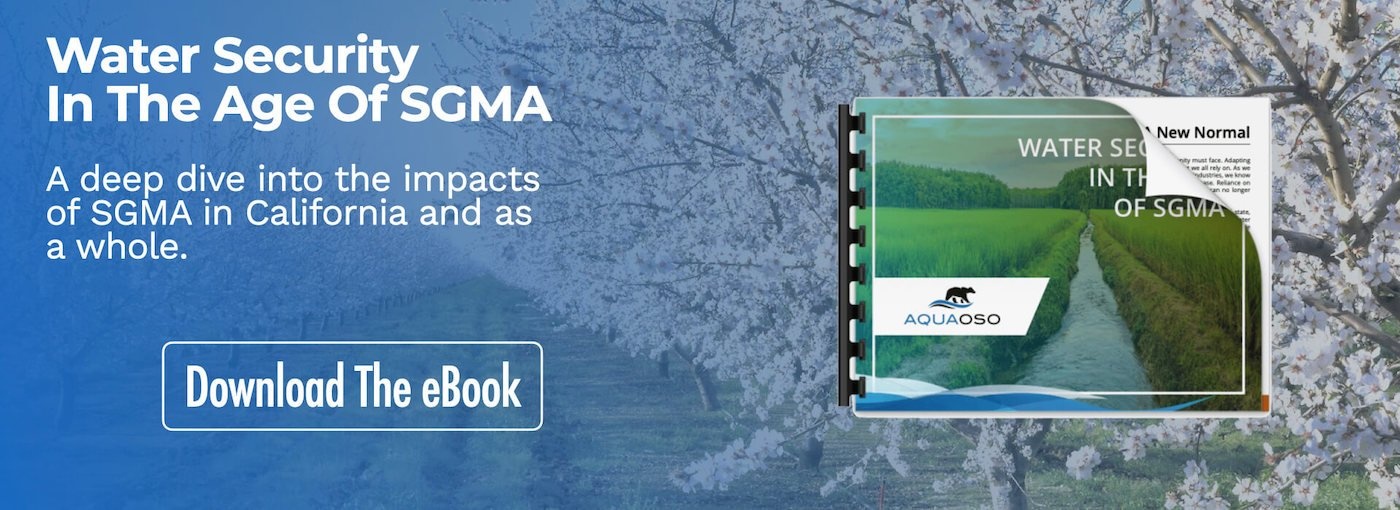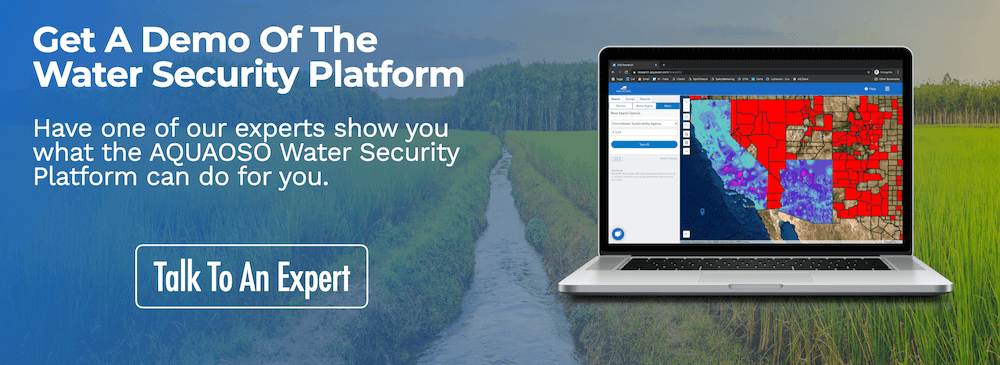California Water Rights – A Breakdown Of The State’s Water Rights System
Part of our Water Rights Guide
Water rights policies may be one of the most important issues for lenders and investors to understand in modern-day agriculture.
Unlike land rights, which have clearly defined boundaries, California water rights are based on a unique hybrid system of rights. Surface water rights can be riparian or appropriative, based on the seniority of the rights, and allocated for a particular type of use. They can also be subject to curtailment in drier times. Groundwater rights, generally referred to as “overlying rights,” are now seeing restrictions for the first time due to SGMA.
Ultimately, this has an impact on the value of the land it’s attached to and determines whether or not a grower can sustain their crops without buying additional water.
“Almost the entire U.S. Southwest, including states such as California, Arizona, New Mexico and Utah, faces extreme water stress issues by 2030.” – BlackRock Investment Institute
As California faces increasing water scarcity issues due to drought and climate change, it will be more important than ever for growers, lenders, and investors along every step of the supply chain to do their due diligence in assessing water rights. After all, water risk is business risk, and companies that factor water rights and water risk into their financial decisions will be in a better position to navigate the changes ahead.
In this post, we’ll present a broad overview of California water rights, as well as how you can get more specific information on a parcel-by-parcel basis.
Background on Water Rights in California
The first step in determining the water risk of a piece of land is to understand what water use policies and regulations apply in the region. In California, the main regulation to be aware of is the Sustainable Groundwater Management Act (SGMA), which was passed in 2014 in order to reduce the depletion of groundwater resources due to irrigation.
In short, it rewrote many of the assumptions that growers had about their water rights, including capping groundwater pumping, even for growers who had been drawing from the same wells for years. Groundwater Sustainability Agencies (GSAs) were created to develop Groundwater Sustainability Plans (GSPs) for 515 basins or subdivisions.
That creates a maze of new regulations for lenders and investors to navigate. Land that was once profitable may have to go fallow due to reduced access to water, while other growers may be able to sell excess water rights in smart water markets.
Another factor to consider is the risk of drought and other environmental issues. While California is frequently exposed to drought, it’s less vulnerable than some other states due to its advanced irrigation infrastructure and drought mitigation plans. You can use the U.S. Drought Monitor to track the current risk of severe drought in California.
How to Confirm That A Water Right Is Valid
The complexity of California water rights makes it difficult to assess a water right at face value without doing some additional research. That’s because California uses a system in which the type of right, the seniority of the right, and the intended use of the water all play a role in determining how much water is allocated to a grower each year.
Appropriative Rights
First, is the right riparian or appropriative? Appropriative rights are claim-based rights – often referred to as “first in time, first in right” – and allow the water to be transported and used for a beneficial purpose. These can either be pre- or post-1914 rights.
Pre-1914 rights have been grandfathered in under a seniority system. Rights granted after 1914 have to undergo a registration process and acquire a permit or license from the SWRCB, or the State Water Resources Control Board.
The three main “beneficial uses” that the SWRCB recognizes are:
- Irrigation
- Municipal
- Industrial
Applications must state what the water will be used for, and users must reapply if their purpose for using the water changes, which may reset their priority date.
To progress from a permit to a license, the user must show that they have been using the full amount of water in line with the permit. If they use less, they may be granted a license for a smaller amount than what they initially applied for.
This is why it’s so important to determine the type of water rights a user has, the priority date (or seniority), and the number of acre-feet per year they’ve been granted.
Riparian Rights
Riparian rights are associated with a piece of land that’s adjoining a waterway. Since riparian rights are based on the “natural flow” of water, the water can’t be transported elsewhere and must be used to benefit the associated property.
There are two key factors to keep in mind concerning riparian rights. The first is that the rights aren’t lost if they aren’t used, the way that appropriative rights are, and all rights holders on the same waterway have the same priority.
The second is that riparian rights can be lost if the land is subdivided. They typically stay attached to the smallest parcel of land adjoining the water source, and they can’t be used on the adjacent pieces, even if they once had riparian water rights.
This means you may need to check the title to ensure that the parcel wasn’t subdivided and then joined back together, losing its riparian water rights along the way.
You can use AQUAOSO’s Water Security Platform to run reports and check the status of riparian water rights for a given piece of land in California.
How to Find and Purchase California Water Rights
Water rights aren’t the only thing to consider when determining the water risk of a piece of agricultural land. It’s worth looking into whether or not the grower will have access to additional water resources at an affordable rate through a smart water market.
Some states, including California, have systems in place for buying and selling water rights, either on a temporary or permanent basis. Between 2009 and 2018, water rights holders in California leased an average of over 1 million acre-feet of water per year, a total of $295 million dollars annually.
While the price of groundwater resources can vary widely between regions and states, water markets like these can go a long way toward mitigating the impact of droughts and water shortages.
It can be incredibly tedious to find various water rights and doing so consumes time and money. AQUAOSO’s Water Security Platform, while not a transactional platform, allows you to save months in finding water rights that may be available for sale in your region as well as analyze the water risk of a particular parcel of land.
In Ventura, CA, the Fox Canyon Groundwater Management Agency uses algorithmic trading to make it even easier to buy and sell groundwater resources. Advancements in groundwater trading can use new technologies to reduce the environmental impacts of irrigation and help create a more water-resilient future.
How to Present a Water Rights Analysis
Water risk can affect stakeholders in every part of the agricultural industry, from growers to lenders to food distributors. It’s important to bring water risk into the discussion when pursuing land deals, appraising a property, investing in infrastructure, and more. But in many cases, the stakeholder making the decision on a loan or investment may be several steps removed from the grower or the water rights holder.
Here’s how AQUAOSO users can apply data from our Water Security Platform to price water risk directly into their loans and other investments:
- First, the loan officer presents data to the credit officer showing that the water source is reliable and the water rights are valid. This mitigates the risk of the loan and makes it more likely for it to be approved.
- The credit officer or senior management can present the information to regulators, showing that the water rights have been factored into the overall water risk of the loan.
- Senior management can present water rights information to investors or the bank’s board to show how water risk is accounted for in the loan.
Additionally, lenders can use the information they’ve gathered on water risk to help growers themselves make more responsible decisions on how to use the land. As AQUAOSO Founder Chris Peacock explains, lenders will be able to “help these borrowers become even better stewards of our land and water resources.”
You can read more about water rights systems in specific states in our Water Rights Guide.
The Bottom Line
Water rights may be complicated, but they play a key role in how easily the agricultural sector can adapt to droughts, natural disasters, and regulatory changes. At AQUAOSO, we help stakeholders understand water risk by aggregating data from multiple sources into one place, so you can compare risk by region or on a parcel-by-parcel basis.
In addition to reaching out to us for a free demo, you can read some of our resources on California Water rights, including our guide to SGMA and our free ebook on Lending a Hand to California Agriculture.
Recent Posts
Sustainable Agriculture Practices That Need Financial Capital
In late 2021, world leaders gathered in Glasgow for COP26, better known as the UN’s climate change conference. With over 25,000 attendees meeting to discuss the efforts needed to address climate change, themes of sustainability, renewable energy and the reduction of...
2022 Sustainable Agriculture Trends for Ag Finance to Be Aware of
With real-world impacts like rising global temperatures, climate change is one of the biggest risk factors agriculture faces today. NOAA reported that 2020 was the second warmest year and the EPA explains a consistent increase of 0.16°F in average surface temperature...
Crucial Ways Agricultural Bank Services Can Contribute to A Sustainable Ag Economy
Ag banks and Farm Credits, enable agribusinesses to attain the financing they need in order to execute functions like harvesting and planting, as well as buying new equipment and combat overhead costs. They allow farmers to operate by engaging in a relationship with...






